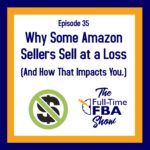Why would anybody sell an item on Amazon for such a low price that they’re actually losing money on the transaction? If you’ve ever been sourcing, found an item, but see it’s for sale on Amazon at or around the same price you’re seeing it sold for in the store you’re at, then you’ve probably felt very confused as to why these sellers would be selling products at a loss.
Today, we walk through why sellers may be inclined to use this “sell at a loss” strategy and how it affects you. There are actually several smart strategies that some sellers employ (at the right times) when they are deciding to sell an item at such a low price. In today’s show, we’ll discuss multiple reasons why a seller would sell at a loss and how these strategies could impact your own Amazon business. To learn about this and more, tune in today!
Listen on the podcast player below.
Like what you hear? Tell a friend… and be sure to leave us a rating and a review. Here’s how.
Key points from episode 35:
 The most common reason an Amazon seller will sell at a loss.
The most common reason an Amazon seller will sell at a loss.- How this forgotten fee can influence sellers’ decision to sell products at a loss.
- The secret benefits most people don’t know about when it comes to pricing below a profit.
- Why selling at losses can actually help as you prep for Q4.
- Why some sellers actually might not be selling at a loss and are still making a profit.
- And more!
Links and resources mentioned in this episode:
 BQool automatic repricer
BQool automatic repricer- My review of BQool (plus how to get my personal repricing rules that doubled my sales the first month I used them)
- My Bqool liquidation repricing rules
- Amazon Storage Fees
- How to Improve your IPI
- Feedback Genius (use code GOPROSMO to get 30% off your first 3 months)
- FREE Full-Time FBA Wholesale Workshop
Right-click here and save as to download this episode to your computer.
 More Episodes from The Full-Time FBA Show podcast:
More Episodes from The Full-Time FBA Show podcast:
Don’t miss an upcoming episode! Subscribe, download episodes, and review the Full-Time FBA Show:
-
-
- Subscribe on iTunes
- Follow on Spotify
- Follow on Amazon Music (or just ask Alexa to “play The Full-Time FBA Show podcast”)
- Follow on iHeartRadio
- Subscribe on Podbean
- Subscribe on Podbay
- Subscribe on Podchaser
-
![]()
 For the longest time I had wanted to add wholesale to my Amazon business. I have actually gone through 3 different wholesale courses to teach me how to do it. Each time I went through a new wholesale course, I would try what was taught, and I kept coming up empty. It was extremely frustrating… then I scheduled a phone call with Dan, one of the guys behind The Wholesale Formula. That conversation opened up my eyes to things about wholesale I’ve never thought about before. I took his advice and began to find multiple wholesale accounts.
For the longest time I had wanted to add wholesale to my Amazon business. I have actually gone through 3 different wholesale courses to teach me how to do it. Each time I went through a new wholesale course, I would try what was taught, and I kept coming up empty. It was extremely frustrating… then I scheduled a phone call with Dan, one of the guys behind The Wholesale Formula. That conversation opened up my eyes to things about wholesale I’ve never thought about before. I took his advice and began to find multiple wholesale accounts.
Would you have wanted to listen in on that conversation? Unfortunately, we didn’t record the call, but Dan created a free online wholesale workshop to help you get started on adding wholesale to your Amazon FBA business. The content in that free video workshop is the same content that I heard in my phone conversation with Dan… and more! Right now, this free online workshop is closed, but I know for sure that it will open it back up again very soon. If you want to be notified when the free wholesale online workshop opens up again, then click here and sign up for the FREE Wholesale Formula workshop wait list.
![]()
Back to the main page for The Full-Time FBA Show
![]()
Episode 35 Transcript:
 [INTRODUCTION]
[INTRODUCTION]
[0:00:01.8] ANNOUNCER: Welcome to The Full-Time FBA Show. In each episode, it’s our goal to help you turn part time hours into a full-time income, selling almost anything on Amazon. Now, your hosts of the show, Stephen and Rebecca Smotherman.
[INTERVIEW]
[0:00:21.3] STEPHEN: Welcome to episode 35 of the Full-Time FBA Show where we share strategies and stories that will help you turn part-time hours into a full-time income. Each week on the podcast we are going to talk about a different topic that will help you with your Amazon business. Today with me is Rebecca, as always. How are you doing, Rebecca?
[0:00:33.7] REBECCA: I’m doing great today.
[0:00:35.1] STEPHEN: Yeah, we’re going to talk today about why some Amazon resellers sell at a loss. But have you ever been sourcing and you find an item that’s selling on Amazon around the same price that you can buy it at in the store or online? It’s kind of weird, you’re like, “Man, sometimes I can even buy it cheaper on Amazon than in the store when I’m trying to like buy this at clearance prices or on sale and it’s selling it at a loss on Amazon.” And like, why are some people selling it that cheap, have you ever experienced that before?
[0:01:03.9] REBECCA: Yeah, I’ve personally seen that happen before. And then other times, this question brought up in Facebook groups that people will say, “I don’t understand, every time I go out and source, all I see is prices that are lower than what it’s selling on Amazon, how are all these people making any money? There must not be any way to make money on Amazon if these people are selling all of these items for such a low price. I can’t sell this without losing money.”
[0:01:29.3] STEPHEN: Yeah, it happens. And so, in this episode, we’re going to talk about why some sellers sell at a loss because there’s actually a strategy that they’re employing and other possible reasons why as well. We’ll talk about that today on the Full-Time FBA show.
[0:01:46.0] REBECCA: Okay, Stephen, let’s talk for a minute about why some sellers are selling at a loss? What is the first reason that you would say that a seller might be selling quote, at a loss.
[0:01:58.1] STEPHEN: Well, one reason why and this is possibly the most common reason is that the seller is just finally giving up. It hasn’t sold. They’re selling it at a loss just so they can get rid of it. They’re liquidating it. They’re just trying to get some capital back so that they can maybe use that capital on other things. And so, they’re okay selling it at a loss.
Maybe they have a repricer that’s setup with the liquidation type of pricing strategy and their prices are just getting lower and lower just so they can get rid of it. That might be one reason why and it often is a big reason why people just getting rid of their stuff. They’ve got too much in stock and they want to sell it out as soon as possible.
[0:02:35.9] REBECCA: I’ve seen this option before, you mentioned the repricer, this is something that we do also when I see in our repricer that there is a liquidation setting, is that something that you’ve set up or is that stock feature of our repricer?
[0:02:49.5] STEPHEN: It’s one that I’ve set up and in fact, if you want to get the actual liquidation and repricing rules, if you go to the show notes page, fulltimefba.com/35, I can show you how you can get the actual liquidation, repricing rules in case you ever wanted to just get rid of some products, no matter what the cost.
[0:03:04.8] REBECCA: Okay, well, I learned something new today. I’ve seen that in our repricer, I don’t personally use that but I’ve seen that in there. Liquidation, that’s the first reason why you might come across an Amazon seller who is selling their items at a loss when you’re looking at items for sale on Amazon and you see other people selling for such a low price. What is the second reason that you would possibly see some other sellers selling so low?
[0:03:31.4] STEPHEN: Well, this comes down to storage fees, whether it’s the monthly storage fees, adding up over time or they’re about to get to the 12-month long term storage fees, which are rolling long-term storage fees after 12 months of storage. Or maybe Q4 is coming and they’re thinking this item isn’t going to sell during Q4 and monthly storage fees during Q4 are about four times as much as the rest of the year, so a lot of times, sometimes people will lower their prices and just to try to stop paying those storage fees that do add up over time. They take away your ROI and they think to themselves, “I just need to sell this at a lower price because I’m tired of paying the storage fees.”
[0:04:13.4] REBECCA: Basically, they’re lowering their price so that they can get the next sale. They’re not looking at how much money can I make on it at this point, they’re looking at, “I just need to get some money back and I don’t want to have to pay storage fees so I’m going to lower it, low enough that it will sell before that storage fee is going to be charged.”
[0:04:30.2] STEPHEN: That’s right, if you’re listening to this and you’re thinking, “Well I never thought about storage fees adding up over time,” be sure to check out the link fulltimefba.com/storagefees. The link will forward you to Amazon’s page giving you all the information about monthly storage fees, Q4 storage fees and long-term storage fees. And you can learn about how those do add up over time and might be stealing your ROI.
[0:04:51.1] REBECCA: Yeah, this is something that when I go into our account and I look at our excess inventory or inventory age reports and it tells you the projected storage fees, it’s a little bit – you could have a heart attack looking at some of those fees.
[0:05:05.3] STEPHEN: Yes, that’s right.
[0:05:07.4] REBECCA: All right. Our next reason that we might see other sellers selling what we think is a loss. Tell us about that, Stephen.
[0:05:15.3] STEPHEN: The next reason sometimes, people might sell at a loss is to improve or increase their seller metrics. And mostly, I’m talking about their inventory performance index. The IPI is very important to keep above a certain number as recording this right now that number is a 400 IPI score and you want to keep above 400 IPA score because that unlocks you to unlimited storage with Amazon FBA.
If your inventory score is a lot lower than that then you’re going to have limited storage with Amazon warehouses and nobody wants that at all. And so, some people try to find some items to sell quickly to help their sell-through rate increase and help increase their IPI score. And so, in fact, if you’re curious about your IPI score, how you can improve it, you can go to fulltimefba.com/improvemyipi, gives you some ideas on how to improve it. But being able to sell some items quickly will definitely help your IPI score.
[0:06:11.6] REBECCA: In that, like you said, is focusing on your sell-through rate. Selling at a loss, even though you’re losing out on that money, it would help your sell-through rate. You’re turning your inventory over faster which means that your IPI would go up, which means that you would not have any type of limits on your storage for in the future.
[0:06:32.8] STEPHEN: Right, that’s one reason why someone might be selling at a loss.
[0:06:36.6] REBECCA: Okay, what’s another reason you’ve got done here for the reason number four that Amazon sellers might sell it at a loss is to increase their feedback score. How would selling at a loss potentially increase your feedback score?
[0:06:50.4] STEPHEN: Well, there are some people who actually purchase items to sell either breaking even or at a loss, simply because they are items that might have an increased chance of getting feedback. And so, maybe they’ve got some negative feedback that they were not able to ask Amazon to remove or they just have some feedback scores neutral or negative feedback that they want to help increase their feedback score. The best feedback score that you can have helps you gain more time in the buy box. The buy box being that little corner, in the top right of an Amazon sales page where over 80% of the sales come from, so you want to have a really good feedback score.
A lot of the times, it’s hard to get feedback. If you’re able to get more sales, even if you’re breaking even or a little bit of a loss, you might be able to increase your feedback score with that, especially if you’re using a software or a tool that automates that feedback request like Feedback Genius.
[0:07:42.0] REBECCA: Can I ask a question here real quick that has kind of like a break out question from the list that we’re going through here? Are you saying that you recommend doing this? Or are you just saying this happens.
[0:07:53.0] STEPHEN: No, I say this happens. I don’t recommend doing it. I don’t choose this as my strategy but there are some people out there who maybe be thinking their Amazon seller account is at risk because their feedback score is too low. And they need to do whatever it takes to increase their feedback score, to increase their metrics with Amazon so they do not need to worry about a seller account being suspended. And so sometimes this is like a last-ditch effort some people do to save their Amazon account before it gets suspended. So yeah, definitely not a strategy I recommend doing. But a strategy that some people do employ.
[0:08:24.2] REBECCA: Okay, I just wanted to clear that up because I don’t want people coming back to us and saying, “Well Stephen said to sell at a loss just for the sake of your feedback score.” Or even for your IPI. You know that is one way to get your IPI to come up. A better way is to buy better selling inventory to begin with. But and the same with feedback just continue to sell products that sell at a good profit that will get you good feedback to you.
We’re just trying to say these are explanations for why you might see that, “Oh this other seller on this item that I want to sell is selling at such a low price, why is that?” Well, here are some reasons why.
[0:09:01.3] STEPHEN: Yes.
[0:09:02.3] REBECCA: Okay I just wanted to clear that up. And on that note, so the fifth thing on our list here of why sellers might be selling at a loss?
[0:09:09.8] STEPHEN: So, the fifth reason is to be able to be approved just to sell merchant fulfilled during Q4. We are recording this in 2020 so I am going to give you the 2019 dates and guidelines. But if you want to sell merchant fulfilled, which means you are selling the items on Amazon, but processing and shipping out the shipments to yourself to your customer, in 2019 if you wanted to be able to be approved to sell toys merchant fulfilled between November 1st and January 3rd then you had to sell 25 merchant fulfilled orders between August 15th and October 14th.
So that is 61 days to fulfill 25 merchant fulfilled orders and so a lot of times people think, “Okay, to go find some items that I can sell for a merchant fulfilled.” And that is good to do. But if you are in crunch time and you’re like, “I need five more quick sales and my time is almost running out. I haven’t sold 25 merchant fulfilled items between August 15th and October 14th.”
Maybe you are just going out and finding an item that you can sell at a loss just so you can be able to meet that criteria of 25 merchant fulfilled orders during that time just so you can be approved to merchant fulfill items during the Christmas holiday selling season between November 1st and January 3rd.
[0:10:26.7] REBECCA: The reason behind that would be then possibly you are selling at a loss for five items, but then that person could make a ton more profits being able to sell possibly dozens or hundreds of items merchant fulfilled over the Q4 season that would well more than make up for those five items.
[0:10:46.6] STEPHEN: Right, we definitely teach people to focus more on FBA during the holiday selling season. But when it gets to crunch time maybe two weeks before Christmas, a lot of times the sales start going to the merchant fulfilled sellers because they can ship out immediately instead of spending the time to pack up your shipments, send it to Amazon two weeks before Christmas hoping it gets checked in, hoping it gets live on time, hoping it gets shipped to the customer on time.
You know the last two weeks before Christmas is probably the best time ever to do merchant fulfilled processing. And so, if you want to be able to be approved to do that, you are going to have to merchant fulfill 25 items between August 15th and October 14th.
[0:11:25.4] REBECCA: Okay, so that brings us to our last item here on the list and this is where it all comes down to why some sellers might be selling at a loss on Amazon. They aren’t necessarily selling at a loss. How do you know that they are selling at a loss?
[0:11:40.2] STEPHEN: Because I have been in that situation before, where someone assumes I am selling at a loss because they think I am paying the same price that they are paying. But I am not. People who are buying things via wholesale sourcing might be able to get those items even cheaper than you can in the retail store or in the online arbitrage sale or in the clearance isle. They are not selling at a loss. They are still making money. They are still making profits because they are buying multiple products at deep discounts because they’re purchasing it via wholesale and so you are not selling it at a loss. They are actually making profit.
And this is the one strategy I do recommend that everyone take when it comes to selling “at a loss” is that you know, find the opportunity to where people think you are selling at a loss but you are actually not because you are getting involved with wholesale relationships. We have a workshop that we are going to be having really soon.
If you want to get on the wait list to be notified when this free workshop about focusing on wholesale opens up, you can go to fulltimefba.com/wholesaleworkshop and I will notify you when the free workshop opens up. And I will teach you, along with my mentors, about how you can get wholesale relationships where you can buy things at such a low price that people think you’re selling it at a loss. But you’re not. You are making money.
[0:12:55.4] REBECCA: All right so that last one is the kicker. You don’t know that other sellers are selling at a lost, they might be and we’ve gone over the five reasons why they might actually be selling their items at a loss. But ultimately, it comes down to you don’t know that. You don’t know what price they paid. You don’t know the cost of goods for their inventory. And so, there is just no way to know that they’re selling at a loss. So, does that about wrap it up?
[0:13:20.9] STEPHEN: Yeah that wraps it up. If anyone is curious about any of the links we’ve talked about or the programs or the tools, they will all be in our shownotes, fulltimefba.com/35 so you will see all of the links there as well as a transcript of this episode. And you can listen to it again if you want because you know that is fine.
[END OF INTERVIEW]
[0:13:41.5] REBECCA: Well, thanks so much for being with us this week. We are so glad that you join us and we look forward to being in your ears again next week when we are going to be talking about the top Amazon myths that you need to stop believing. Be sure to join us for that one, it will be great.
[0:13:56.1] STEPHEN: Yep, and we’ll talk about some things that maybe are stopping you from growing your business because you are believing in something that is not true.
[0:14:02.8] REBECCA: All right. Well, have a great week and we’ll be back with you next week.
[OUTRO]
[0:14:09.6] ANNOUNCER: That is all for this episode of The Full-Time FBA Show. So, head over to fulltimefba.com/podcast, where you will find the shownotes and links from this episode. While you’re there, subscribe to our newsletter where you’ll get several free downloads of our popular and helpful Amazon FBA resources. Now, take action on what you have learned today so you can find success at turning part time hours into a fulltime income with Amazon FBA.
[END]

Leave a Reply